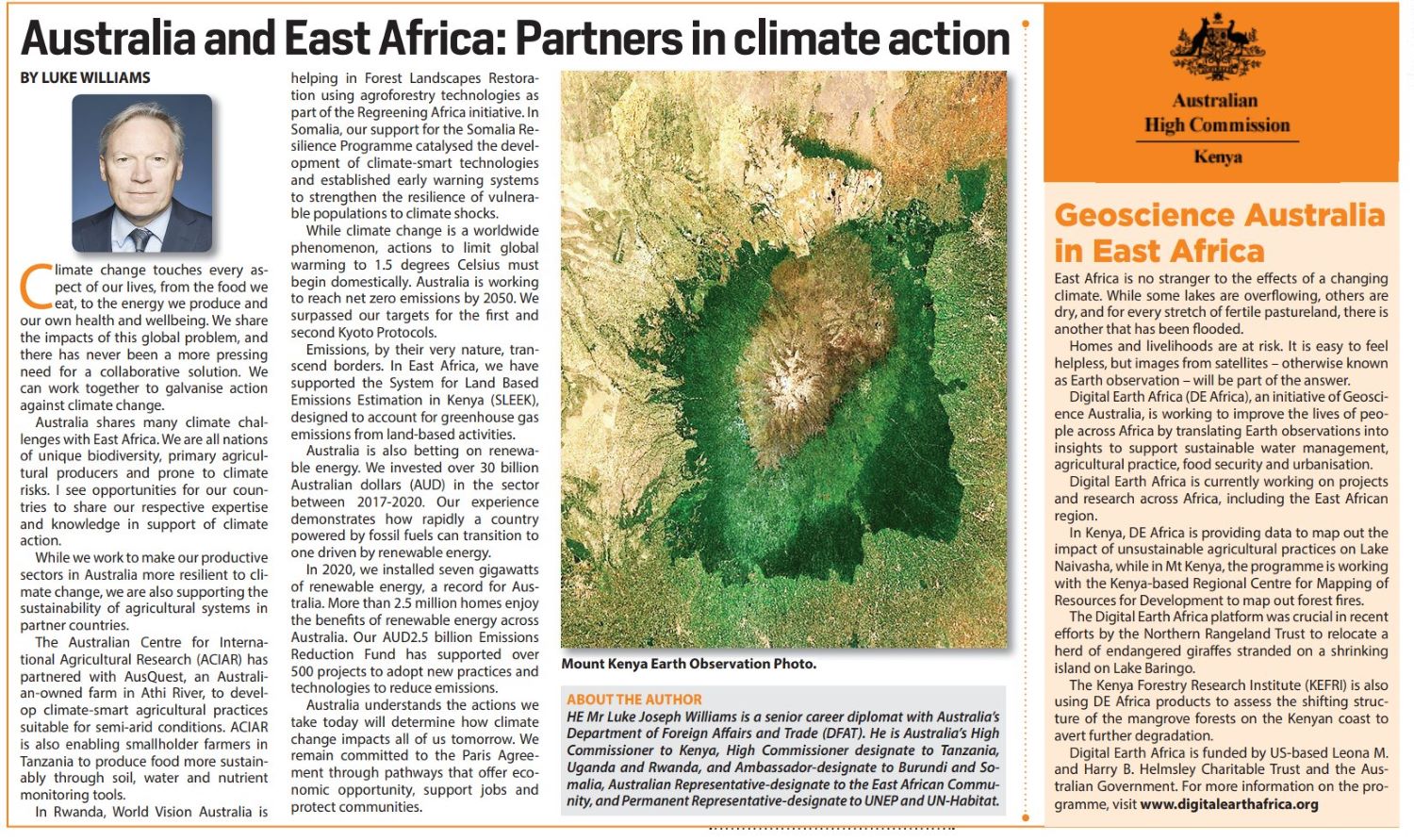
By Luke Williams (first published in the Sunday Nation, 30 May 2021)
Climate change touches every aspect of our lives from the food we eat, to the energy we produce and our own health and wellbeing. We share the impacts of this global problem, and there has never been a more pressing need for a collaborative solution. We can work together to galvanise action against climate change.
Australia shares many climate challenges with the East Africa region. We are all nations of unique biodiversity, primary agricultural producers and prone to climate risks. I see opportunities for our countries to share our respective expertise and knowledge in support of climate action.
While we work to make our productive sectors in Australia more resilient to climate change we are also supporting the sustainability of agricultural systems in partner countries.
The Australian Centre for International Agricultural Research (ACIAR) has partnered with AusQuest, an Australian-owned farm in Athi River, to develop climate-smart agricultural practices suitable for semi-arid conditions. ACIAR is also enabling smallholder farmers in Tanzania to produce food more sustainably through soil water and nutrient monitoring tools.
In Rwanda, World Vision Australia is helping in Forest Landscapes Restoration using agroforestry technologies as part of the Regreening Africa initiative. In Somalia, our support for the Somalia Resilience Program catalysed the development of climate-smart technologies and established early warning systems to strengthen the resilience of vulnerable populations to climate shocks.
While climate change is a worldwide phenomenon, actions to limit global warming to 1.5 degrees Celsius must begin domestically. Australia is working to reach net zero emissions by 2050. We surpassed our targets for the first and second Kyoto Protocols.
Emissions, by their very nature, transcend borders. In East Africa, we have supported the System for Land Based Emissions Estimation in Kenya (SLEEK), designed to account for greenhouse gas emissions from land-based activities.
Australia is also betting on renewable energy. We have invested over AUD30 billion in the sector between 2017-2020. Our experience demonstrates how rapidly a country powered by fossil fuels can transition to one driven by renewable energy.
In 2020 we installed seven gigawatts of renewable energy, a record for Australia. More than 2.5 million homes enjoy the benefits of renewable energy across Australia. Our AUD2.5 billion Emissions Reduction Fund has supported over 500 projects to adopt new practices and technologies to reduce emissions.
Australia understands the actions we take today will determine how climate change impacts all of us tomorrow. We remain committed to the Paris Agreement through pathways that offer economic opportunity, support jobs and protect communities.
Mr Luke Williams is Australia’s High Commissioner to Kenya, High Commissioner designate to Tanzania, Uganda and Rwanda, and Ambassador-designate to Burundi and Somalia.
Geoscience Australia in East Africa
East Africa is no stranger to the effects of a changing climate. While some lakes are overflowing, others are dry, and for every stretch of fertile pastureland, there is another that has been flooded.
Homes and livelihoods are at risk. It is easy to feel helpless, but images from satellites – otherwise known as Earth observation – will be part of the answer.
Digital Earth Africa (DE Africa), an initiative of Geoscience Australia, is working to improve the lives of people across Africa by translating Earth observations into insights to support sustainable water management, agricultural practice, food security and urbanisation.
Digital Earth Africa is currently working on projects and research across Africa, including the East African region.
In Kenya, DE Africa is providing data to map out the impact of unsustainable agricultural practices on Lake Naivasha, while in Mt Kenya the Program is working with the Kenya-based Regional Centre for Mapping of Resources for Development to map out forest fires.
The Digital Earth Africa platform was crucial in recent efforts by the Northern Rangeland Trust to relocate a herd of endangered giraffes stranded on a shrinking island on Lake Baringo.
The Kenya Forestry Research Institute (KEFRI) is also using DE Africa products to assess the shifting structure of the mangrove forests on the Kenyan coast to avert further degradation.
Digital Earth Africa is funded by US-based Leona M. and Harry B. Helmsley Charitable Trust and the Australian Government. For more information on the program, visit www.digitalearthafrica.org